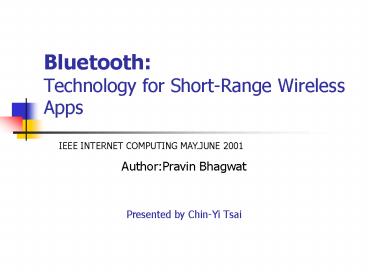Bluetooth: Technology for ShortRange Wireless Apps - PowerPoint PPT Presentation
1 / 28
Title:
Bluetooth: Technology for ShortRange Wireless Apps
Description:
The end of 1999 this number had increased to nine through the addition of 3Com, ... Inquiry scan. ID Packet with inquiry Access Code. Randome delay. before ... – PowerPoint PPT presentation
Number of Views:173
Avg rating:3.0/5.0
Title: Bluetooth: Technology for ShortRange Wireless Apps
1
BluetoothTechnology for Short-Range Wireless
Apps
IEEE INTERNET COMPUTING MAY.JUNE 2001
- AuthorPravin Bhagwat
- Presented by Chin-Yi Tsai
2
Outline
- Introduction to Bluetooth
- Bluetooth Specifications
- The Frequency Hopping technique
- Inquiry and Paging
- Piconets and Scatternets
- Bluetooth Applications
- Conclusions
3
Introduction to Bluetooth
- Why Bluetooth?
- Bluetooth History
- Bluetooth Feature and motivation
4
Why Bluetooth?
- 10th Century Denmark King
- King Harald united Denmark and Norway. Bluetooth
of today will unite the world of computers and
telecom
5
Bluetooth History
- The Bluetooth Special Interest Group(SIG)
- Initially the group comprised five
companies-IBM,Intel,Ericsson,Nokia,Toshiba - The end of 1999 this number had increased to nine
through the addition of 3Com, Motorola,
Microsoft, Lucent - By December 2000 the Bluetooth SIG had over 2000
members
6
Bluetooth feature and motivation
- Bluetooth feature
- ISM 2.4 GHz
- Small
- Simple
- Low cost
- Low power
- Short range
- Voice and data
- Point-to-point and point-to-multipoint
7
Bluetooth feature and motivation
- Bluetooth motivation
- Started as cable replement technology
- Connecting with different devices
- Mobile acces to LANs/Internet
- Personal Area Network(PAN)
- Automatic synchronization of data
8
Bluetooth Specifications
- Core specification
- The core specification defines all layers of the
Bluetooth protocol stack - Profile specification
- Special protocol
- different device,OS, and application
- interoperability
9
Bluetooth Specifications
Applications
OBEX
SDP
TCS
WAP
RFCOMM
AT Commands
L2CAP
Host Controller Interface
Link Manager
Baseband/Link Controller
Radio
The Bluetooth protocol stack
10
Radio
- Frequncy
- 2.40002.4835 GHz(license-free)
- Powerthere are three power class
- 1mW,2.5mW,100mW
- Modulation
- GFSK
11
Baseband
- Physical channel
- Formed after connection
- Transmition type
- SCO(cricuit switch)point-to-point,voice
- ACL(packet switch),point-to-multipoint, data
- Error correction
- 1/3 FEC,2/3 FEC ,ARQ
- Timer synchronization
12
Baseband
- Link controller state
- Standby
- Intermediateinquiry,inquiry scan,inquiry
response,page,page scan,page response,master
response - Connectionactive,sniff,hold,park
13
LMP
- Piconet management
- Attach and detach slave
- SCO and ACL connection,management
- Switch role of master,slave
- Handling low power
- Link configuration
- QoS
- Security function
- Authication,encryption,link key
14
Host Controller Interface
- Host control Bluetooth module
15
L2CAP
- Protocol multiplexing
- Segment and reassembly
- Negotiation
- MTU(maximum transmission unit)
- Flush timeout
- QoS
16
Others
- RFCOMM
- TCS
- WAP
- OBEX
- PPP
17
Profile Specifications
- Generic access
- Service discovery
- Cordless telephone
- Intercom(Walkie-Talkie)
- Serial port
- Headset
18
Profile Specifications
- Dial-up networking
- Fax
- LAN access
- Generic object exchange
- Object push
- File transfer
- Synchronization
19
The Frequency Hopping technique
1MHz
1
79
- Divide Frequency band into 1 MHz hop channels
- Radio hops from one channel to another in a
pseudo - -random manner as dictated by a hop sequence
- Hopping sequence is different for each
piconet(masters device address and clock) - Hop rate1600 time/second
20
The Frequency Hopping technique
f(2k)
f(2k2)
f(2k4)
f(2k1)
f(2k3)
f(2k5)
Master
Slave1
Slave2
Slave3
1 slot
21
Inquiry and Paging
- The purpose of inquiry and paging
- Connection establishment
Connected
Paging
Inquiry
22
Inquiry and Paging
Master
Slave
Start inquiry
Inquiry scan
FHS Packet
Inquiry result
Inquiry complete
23
Inquiry and Paging
Master
Slave
Page
Page Scan
Slave Page Response
Master Page Response
Uses FHS to get CAC and clk info
Assigns active addr
Connected
Connected
24
Piconets and Scatternets
- Bluetooth unit can communicate with other units,
by forming a piconet - One unit of a piconet is defined as the master
(the unit that establishes the piconet), the
others units are called slaves - One piconet consists of 1 master and up to 7
slaves
25
Piconets and Scatternets
- A group of piconets in which connections consists
between different piconets is called a scatternet - A unit cannot be the master in different piconet,
since the master determines the property of a
piconet
A scatternet example
26
Bluetooth Applications
- Three-in-one Phone
- Ultimate Headset
- Automatic Synchronizer
- Internet Bridge
- Interactive Conderence
- Indoor positioning
27
Conclusions
- Bluetooth eliminates the need for numerous and
inconvenient cable attachments for devices - Bluetooth enables the design of low-power,
small-sized, low-cost radios that can be embedded
in existing (portable) devices - The Bluetooth technology will be built into
hundreds of millions of electronic devices in
2005 - Commpared with 802.11 and HomeRF
28
Transmition type
SCO
SCO
SCO
ACL
ACL
Master
Slave1
Slave2
Slave3































